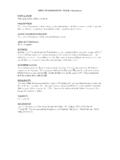Transcription of Tinetti Assessment Tool: Description - Home | Stall Senior ...
1 Tinetti Assessment tool : Description Population: Adult population, elderly patients Description : The Tinetti Assessment tool is a simple, easily administered test that measures a patient's gait and balance. The test is scored on the patient's ability to perform specific tasks. Mode of Administration: The Tinetti Assessment tool is a task performance exam. Time to Complete: 10 to 15 minutes Time to Score: Time to score is included in time to complete Scoring: Scoring of the Tinetti Assessment tool is done on a three point ordinal scale with a range of 0 to 2.
2 A score of 0 represents the most impairment, while a 2 would represent independence of the patient. The individual scores are then combined to form three measures; an overall gait Assessment score, an overall balance Assessment score, and a gait and balance score. Interpretation: The maximum score for the gait component is 12 points. The maximum score for the balance component is 16 points. The maximum total score is 28 points. In general, patients who score below 19 are at a high risk for falls. Patients who score in the range of 19-24 indicate that the patient has a risk for falls.
3 Reliability: Interrater reliability was measured in a study of 15 patients by having a physician and a nurse test the patients at the same time. Agreement was found on over 85% of the items and the items that differed never did so by more than 10%. These results indicate that the Tinetti Assessment tool has good interrater reliability. Validity: Not reported References: Lewis C. Balance, Gait Test Proves Simple Yet useful. Bulletin 1993; 2/10:9 & 40. Tinetti ME. Performance-Oriented Assessment of Mobility Problems in Elderly Patients.
4 JAGS 1986; 34:119-126. Tinetti Assessment tool : Balance Patient's Name: _____ Date: _____. Location: _____ Rater: _____. Initial Instructions: Subject is seated in a hard, armless chair. The following maneuvers are tested. Task Description of Balance Possible Score 1. Sitting Balance Leans or slides in chair = 0. Steady, safe = 1. 2. Arises Unable without help = 0. Able, uses arms to help = 1. Able without using arms = 2. 3. Attempts to arise Unable without help = 0. Able, requires > 1 attempt = 1. Able to rise, 1 attempt = 2.
5 4. Immediate standing Unsteady (swaggers, moves feet, trunk sway) = 0. balance Steady but uses walker or other support = 1. (first 5 seconds) Steady without walker or other support = 2. 5. Standing Balance Unsteady = 0. Steady but wide stance (medial heels > 4 = 1. inches apart) and uses cane or other support Narrow stance without support = 2. 6. Nudged (subject at Begins to fall = 0. max position with feet Staggers, grabs, catches self = 1. as close together as Steady = 2. possible, examiner pushes lightly on subject's sternum with palm of hand 3 times.)
6 7. Eyes closed (at Unsteady =0. maximum position #6) Steady =1. 8. Turning 360 degrees Discontinuous steps =0. Continuous steps =1. Unsteady (grabs, swaggers) =0. Steady =1. 9. Sitting Down Unsafe (misjudged distance, falls into chair) =0. Uses arms or not a smooth motion =1. Safe, smooth motion =2. Balance Score: Tinetti Assessment tool : Gait Patient's Name: _____ Date: _____. Location: _____ Rater: _____. Initial Instructions: Subject stands with examiner, walks down hallway or across the room, first at usual pace, then back at rapid, but safe pace (using usual walking aids).
7 Task Description of Gait Possible Score 10. Initiation of gait Any hesitancy or multiple attempts to start =0. (immediately after told No hesitancy =1. to go ). 11. Step length and a. Right swing foot does not pass left stance =0. height foot with step b. Right foot passes left stance foot =1. c. Right foot does not clear floor completely =0. with step d. Right foot completely clears floor =1. e. Left swing foot does not pass right stance =0. foot with step f. Left foot passes right stance foot =1. g. Left foot does not clear floor completely with =0.
8 Step h. Left foot completely clears floor = 1. 12. Step Symmetry Right and left step length not equal (estimate) = 0. Right and left step appear equal = 1. 13. Step Continuity Stopping or discontinuity between steps = 0. Steps appear continuous = 1. 14. Path (estimated in Marked deviation = 0. relation to floor tiles, Mild/moderate deviation or uses walking aid = 1. 12-inch diameter; Straight without walking aid = 2. observe excursion of 1 foot over about 10. feet of the course). 15. Trunk Marked sway or uses walking aid =0.
9 No sway but flexion of knees or back, or spreads =1. arms out while walking No sway, no flexion, no use of arms, and no use of =2. walking aid 16. Walking Stance Heels apart =0. Heels almost touching while walking =1. Gait Score: Balance + Gait Score.


